 I think many of you might remember, that in those early posts of mine, I would only add one picture to each one of my posts. There are many of those posts that I would (retrospectively) like to go back and add many more pictures than just the single one I used to post at the time. Everyone seems to enjoy the increased numbers of photos that I started adding at several bloggers requests sometime last summer. This is one of those that definitely needs more photos and even more time for discussion. If you remember it, it was in fact the one I posted about Millennium Park back then, of Mrs. LZ and me standing on what “is known as” the BP Pedestrian Bridge. It was really one of the most unique footbridges I have even been on in a city anywhere that I can recall. This is the first bridge designed by architect Frank Gehry, and also doubles as a sound barrier from the traffic of Columbus Drive. Designed in such a way as to provide a smooth transition over Columbus Drive, the bridge does exactly that and more. I heard somewhere that the bridge had a 5 degree incline to it. But it really did seem easy to traverse it; you don’t even notice that you’re over the road until you hear the cars driving underneath you. You may notice the cops on Segways at the other side of the bridge as we were walking toward the lake? Originally they proposed to put a suspension bridge over the drive, but they thought it might waste too much space. Gehry designed this bridge, and frankly it does a great job of winding over Columbus Drive, while providing an interesting study in stainless steel bridge construction. From overhead you can really tell how well the bridge curves in and out, moving up and down depending on where you're standing. Millennium Park itself opened less than four years ago on July 16th, 2004 and is located in Chicago bounded by Randolph Street to the North, Columbus Drive to the East, Monroe Drive to the South and the great Magnificent Mile, Michigan Avenue, to the West. The park was originally just an open expanse with railroads and parking and an unsightly eyesore in Chicago's great front lawn that is Grant Park, and is now one of Chicago's most enjoyed public spaces. The park has been open now for almost two years and its effect on the surrounding area has been astounding. New restaurants, condominiums, hotels and various amenities have cropped up around the park making it an even more vibrant area to enjoy. Some of the other stuff there that I loved was the Cloud Gate sculpture. Originally this piece thought to have been assembled somewhere else, then brought by barge to Chicago, but this did not occur due to various issues. This piece will not be ready for the official opening of the park, but was on view for the public to see. They were barely able to make it in time for a September completion date. By then, all that was left was to weld and polish the sculpture to a beautifully unique and seamless marvelous looking structure. Anish Kapoor is world-renowned for his large art sculptures, and this addition to the park was really being something spectacular to see. This was the artist's first permanent piece in the United States, and will continue to add to Chicago's tradition of providing exceptional public art to its citizens. The Gehry bandshell as it is called has an interesting story in the way that it came about. (Shown in the top picture.) Initially the idea was that the park would have a modest venue in which it would handle around 30,000 people (if you call that modest?) That proposal was introduced by Mayor Daley on March 21, 1998. Some may say then that they were missing out, because now the capacity is pegged around 11,000 with 4,000 of those being permanent seating, and the rest on the great lawn behind it. I’m not sure if the thirty thousand estimate was a case of being overly optimistic, given how small the area is, but clearly the park would have been nothing more than the bandshell if that had been the case. One more thing that truly blew my mind was Crown Fountain that was designed by Jaume Plensa. This is probably my favorite addition to the park besides the Gehry Bandshell and Bridge, is this new double fountain with two towers each 50 feet high that display images and video. This fountain designed by Spanish artist Jaume Plensa was funded by a donation from Crown Family, is really a prototype of the future of what modern fountains will try to emulate. Kruek & Sexton Architects are the ones who actually built these wonderful twin fountain towers. I hope you enjoy the extra shots and verbiage? "I give you Chicago. It is not London and Harvard. It is not Paris and buttermilk. It is American in every chitling and sparerib. It is alive from snout to tail." ~ H L Mencken       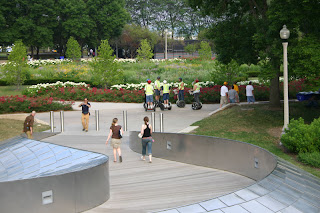    
|
 Well at last, spring is finally here and "none-too-soon" for me. This time of year always reminds me of a trip that Mrs. LZ and I took several years ago to central Nebraska. Although this was only a one time visit for us, and quite a thrill for any amature ornithologist (or maybe just bird-watcher) this little adventure happens at this percise time every year and has for literally thousands and thousands of years. It is what is known fondly as the annual migration of the Sandhill cranes. In order to view this world's largest concentration of Sandhill cranes from observation blinds on the banks of the Platte River in South Central Nebraska, it is necessary to get up very early when these birds are most active. There are trips conducted every year during March and early April, when over a half a million Sandhill cranes along with hundreds of thousands of ducks and geese converge on the Platte River there. One such opportunity is taken from a place called Rowe Sanctuary. The Rowe Sanctuary is about the most famous and is located right in the heart of this magnificent Sandhill crane staging area where the birds can be viewed in huge gatherings on their nighttime roosts. Trips to our observation blinds are timed to provide the best opportunities to see this spectacle. Group sizes are limited to maintain the quality and uniqueness of the experience. If you can look at a map of North and South America and try and imagine it was overlaid with the outline of an hour glass, and then imagine these birds flying from the most further most eastern and western points of Mexico and even South America, then making the center of the hour glass overlap a much smaller area between Grand Island and Kearney Nebraska, before it spreads out again at it top up in Canada and Alaska, then you can visualize this yearly path at its smallest and most concentrated amount of birds. A typical field trip to see the birds, begins and ends with a walk of between 1/4-1/2 mile over level terrain. Morning trips start before dawn as the blinds must be approached under the cover of darkness to prevent spooking the cranes. In the evening, tours arrive at the blinds before the sun sets to view the Sandhill cranes as they return to the river and stay until dark. Benches are available for resting, but the blinds are not heated. The field trips from Rowe take place every morning and evening from early March through early April. Although they take "walk-ins" when space is available, they also encourage you to call after the first of the year to make your reservations. The birds themselves are just awesome to watch as they conduct their little mating ritual dances. Cranes are among the oldest living birds on the planet. Fossil records place Sandhill Cranes in Nebraska more than nine million years ago, long before there was a Platte River, which, by comparison, is only a youthful 10,000 years of age. The landscape then was savanna-like and its inhabitants were more like that of modern East Africa; varieties of rhinos, camels, and elephants long since extinct. Yet cranes survived and watched as American bison, pronghorn, and wapiti evolved on the prairies. Humans now dominate the landscape having replaced the bison with cattle and the prairie with corn and concrete. This startling transition occurred in less than 150 years, a mere blink of an eye in geologic time! Witnessing the gathering of half a million cranes under a blazon Nebraska sunset stirred our senses and sparked our imagination like very few experiences could. What better way to rejuvenate your spirit than with the sights and sounds of such a spectacle with a cold March wind slapping your cheeks? "Why do they stage here along the Platte?", "Where are they going", and "Where do they come from?" are but a few of the many questions visitors ask. At dawn, (which was our favorite time to watch them) the cranes leave the river and head to the fields to feed. They usually range within five miles of the river. The cornfields provide the cranes with a source of energy, while meadows and alfalfa fields provide essential proteins and minerals. They also serve an important social function as loafing and courtship areas. Another viewing place that we visited while there was the Crane Meadows Nature Center, which was on Alda Road in Wood River, NE. At dusk, the cranes gather along the broad, shallow reaches of the Platte River to roost for the night. They prefer to stand in water about six inches deep, taking on the configuration of submerged sandbars. Densities of more than 12,000 cranes per half mile of river can occur. During inclement weather they seek out the narrower, more protected stretches of the river. At this time of year occasionally, the river freezes, and the birds must roost in the fields adjacent to the river, huddled together for warmth and protection. There were times when we looked up in the sky and it was almost like one of the “end of the world” movies where the locusts come to attack the fields and the sky is actually darkened by their sheer numbers. Only instead of being the size of a locust, they are about the size of a flamingo and look very much like a whooping crane only gray rather than white. As I got close enough with my camera (even with the telephoto lens) these things would all take off together in one giant exodus. (No pun on my previous locust reference either). As you can see from most of the closer photos I’ve taken here, the cranes have a red patch on their heads. I was hoping that there was some way to distinguish the males from the females, but alas, I couldn’t figure it out. But it's OK, becuase I am sure that they can! These Sandhill Cranes are have a height of 3-4 feet, a wingspan of 6 feet, they weigh from 8-12 pounds and fly at a speed of 38 miles per hour. They are also diurnal or daytime migrants and use thermals to their advantage. They will ride the thermal higher and higher up to an altitude of a couple of thousand feet, then they will glide northward in wavering lines losing altitude as they go until they reach the next thermal, spiraling upwards to repeat the process. This method of migration is energy efficient, more so than the power-flapping flight of other species such as geese. On a good day, cranes can travel up to 500 miles although 200 to 300 miles is more typical. In the late afternoon, they seek a wetland of some type to roost for the night and depart the next morning weather permitting, until they reach their destination. This stop for them is a halfway point and they rest up for the rest of their trip. I am not saying that everyone needs to make this adventuresome trip, but if you love watching birds (as LZ does) then, I am sure that you will never see a site like this again in your life. I was also amazed that these huge birds seemed to be afraid of humans, but as you can see from a couple of my shots, they didn't seem to mind grazing in the harvested corn fields right next to the cattle. Their flight was amazing to watch, and even though I tried to catch its grace and beauty, it just can't all be captured on any media as far as I am concerned. For those of you out there who are Christians, I want to wish you all and your families a very Blessed Easter! Like the picture of the sun at sunrise at the top of my blog template, the Son of man has risen and has risen indeed. "He is not here; for he is risen, as He said..." Matthew 28:6 "I never for a day gave up listening to the songs of our birds, or watching their peculiar habits, or delineating them in the best way I could." ~ John James Audubon  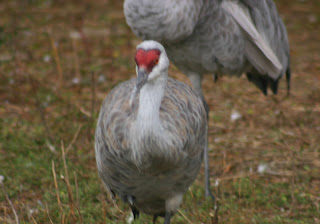       
|
 I had to take a business trip last week to Des Moines, Iowa. So as any good amateur photographer would do, I took my trusty camera along with me. This was not by any means my first trip to this Capital City of Iowa, but it was the first time I ever took pictures of their beautiful state capital building. I once was given a guided tour of the capital building and was very impressed with the restoration they had completed in just the last few years. As you can see with these pictures, the Capital building was just about my favorite building in the city. This was not however by any means the largest building in the city. That honor was given to the head quarters of the Principle Financial Group. You can see it is the tallest building in the city’s skyline as I took the photo from the capital building, area and then another one from the downtown area. I would say that the capital building appears to sit up on top of a hill and overlooks the cityscape below it. As you can also see, there was a really (almost surreal) sculpture in the downtown redevelopment area that I thought looked really interesting but it was also difficult to figure out exactly what it was for, or for that matter, even what it was trying to represent. I just thought that it was very cool. What the heck is that? It seems to be made out of just white capital block letters. But it seems to be a part of the downtown redevelopment that is going on down there not far from the Principle Financial Group's building. I was surprised and how many things there were to do in this city of about a quarter million people. From things like the Blank Zoo, and the Living History Farms, to the Arboretum (called the Botanical Center) and even their very cool Des Moines Art Center, (a very neat place) for not only art, but also for the shear contemporary architecture of the facility. I was very impressed with this place from a visit there a few years ago. For all of you who care, the history of Des Moines can be traced back to 1834, when John Dougherty, an Indian Agent at Fort Leavenworth, Kansas, recommended that a military post be established at the point where the Des Moines and Raccoon Rivers merge. Nine years later, May 1843, Captain James Allen and a company of dragoons from Fort Sanford arrived on the site. Captain Allen proposed to name the garrison Fort Raccoon but was directed by the War Department to use the name Fort Des Moines. This made me ponder the possibility of the Iowa state capital now being called Raccoon! Settlers began locating almost immediately near the fort. Streets were platted in 1847. The date of incorporation was September 22, 1851 and the first town election was held October 18 when 25 voters unanimously approved the town charter. On October 20th, eight councilmen were elected, and at their first meeting on October 25th, the Reverend Thompson Bird became the first president of the town council. The town continued under the 1851 charter until January 18th, 1853 when the Iowa Fourth General Assembly passed "An Act to Incorporate the Town of Fort Des Moines in Polk County, Iowa. In 1857, Fort Des Moines was shortened to Des Moines and later that year the city was designated the capitol of the State of Iowa. During the 1900s issues such as the development of permanent roads, new health laws and women's suffrage dominated debate. But with the onset of World War I in August of 1914, expansion slowed as the country braced itself for war. To aid in the nation's war effort, Camp Dodge was established in 1917 and more than 100,000 Iowans were trained for combat. Des Moines suffered the loss of many young men during the war. As those who were lucky enough to survive returned home, they faced unemployment. In January 1919, Mayor Tom Fairweather estimated that over one thousand veterans needed jobs and urged businesses in the City to assist with this growing problem. Local construction programs helped ease the situation, and the early 1920s saw an increase in building, particularly for Des Moines schools. Although much of the boom that Des Moines experienced in the 1920s came to a halt with the stock market crash of 1929, the City fared surprisingly well throughout the 1930s. Federally funded projects supplied work that improved the City, including new bridges and streets. By 1941, Des Moines' populations had grown to 160,000 but as 1942 began, the City changed significantly as the nation entered WWII. As in most U.S. cities, food became scarce and thousands of men left the workforce to join the service. By the end of the War era, Des Moines began to pick up the pieces and concentrate on improving the quality of life. Many businesses flourished in the post war climate, and the City soon emerged as a major insurance center. Other businesses located in Des Moines prospered and the City breezed through the next three decades with a healthy economy. Current information on business and employment statistics in the City of Des Moines indicate that the city continues to thrive. Today almost 250,000 people live in Des Moines, and the City is recognized as a center for government, education, business, culture, and the arts. Des Moines also has gained national recognition as a major insurance center (the third largest in the world) with nearly 60 life, health, and casualty companies. The City's climate-controlled skywalk system serves as an important link to parking garages, hotels, restaurants, stores, and businesses. Des Moines Skywalks make up more blocks per capita in Des Moines than in any other city of comparable size in the U.S. The City's numerous tourist attractions and facilities have also established it as a popular and thriving Midwestern city. As you can see from these pictures, these Skywalks are really very helpful during these winter months. For those of you who have ever been to Minneapolis in the winter, you’ll know exactly what I am talking about. The internationally-acclaimed Iowa State Fair is the single largest event in the state of Iowa and one of the oldest and largest agricultural and industrial expositions in the country. Mrs. LZ and I actually went to this shortly after moving to the Midwest and were actually blown away by all of the folks (and stuff) that showed up here in the state fair grounds in Des Moines. By the way, if you can get it on a stick and into a deep fryer, you’ll find it here for sale while the Iowa State Fair is going on. I think when most people think of Iowa, the first things they think of are: corn and then pigs and then every Bissextile Year, they also think about this state being the first in the nation to have a primary and caucus’ to elect a President. A distinction (by the way) that they went very far to preserve just this year, by even moving their primary up to the third of January. All in all, though I would say that it was a nice place to visit, and I really loved the capital building. "Though we travel the world over to find the beautiful, we must carry it with us or we find it not." ~ Ralph Waldo Emerson 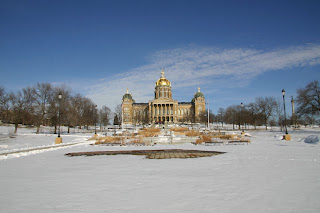      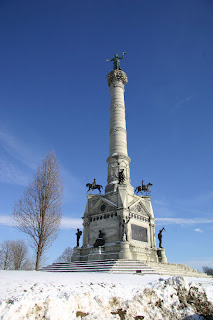   
|
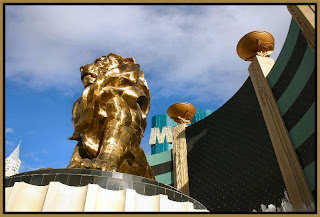 Well as promised… I have decided to finish my post about Las Vegas, Nevada. It took me almost two posts in that last post to get through the history of Vegas, which seemed to take almost as long to read as the actually history may have taken. I was really very surprised by how many people posted a response, which stated they had never been to Vegas. But perhaps my surprise was just because I lived in Southern California for so many years, and it was no big deal to make the drive over to Vegas whenever we felt the need. Even though it was a several hour drive from Orange County to Las Vegas, Nevada was something we did often when I was younger. (Maybe young and stupid would more aptly apply here?) Of course… in those days, Las Vegas was not the big opulent deal it is today. In fact in the short 10 years since I had last been there, this place had really turned into a beautifully classy desert oasis. This is a stark comparison to the neon city in the desert where gambling was “the king” and only a few of the larger hotels had major headliner shows working on the strip. While Mrs. LZ and I were in town (to celebrate my birthday), we took in a musical “Mama Mia”; which if you enjoy Abba, would be a great treat for you (as it was for us). We also caught a couple of typical cabaret type shows that frankly didn’t do a whole lot for either of us. But none the less, we were glad we got a chance to experience them. We also just had to eat at the “Planet Hollywood” Restaurant, just so we could say that we did it. Several others caught my eye as well like, Margaritasville and “In & Out” was a must for a burger, shake and fries and of course a tourist t-shirt. Mrs. LZ opted out of going with me on the roller coaster (that goes around the front of New York, New York), but I went ahead by myself and had a great time. I still have a love of roller coasters from the days when I was a little boy and went on my first ride on one at about 12 years old. That is when my mother’s cousin took me on the old wooden roller coaster at the Pike Amusement Park on the beach in Long Beach, California, before it was torn down for condos in the pre-Jurassic period. I love that that memory has stuck with me all of those years. And this one at NY/NY was very high tech and as smooth as glass. Not the vibrations that the old wooden ones had that gave you a headache and loosened your tooth fillings. We did a lot of walking around the city, but also had passes on the monorail and drove down to the old downtown area. Of all the things that I will remember about this trip, one that will remain with me for a long time, was standing in front of the Bellagio Hotel at night when all of a sudden, the load speakers came on and fountains lit up and starting firing water bursts hundreds of feet in the air in sync with the sound of Sinatra singing out “Luck Be a Lady Tonight”! It was a good thing that they shut off the fountains at the end of the song, or I may have still been there watching and listening to that song and water show. I’ve stuck several of my favorite shots of the city-scapes while we were there down below, but the ones I really liked the best were the ones taken of the old downtown area which was more like I remembered Vegas in the 60’s and 70’s. Frankly the nostalgic neon lights of old were not the only sights there that were enjoyable. I loved the Canals of Venice that wandered through the Venetian Hotel and into the mall and then even outside. The statues that were actually real live people were also kind of fun, but also a little frightening, if you didn’t happen to realize they were actually real folks in there under all of that neat make-up. “I have wandered all my life, and I have traveled; the difference between the two is this -- we wander for distraction, but we travel for fulfillment.” ~ Hilaire Belloc 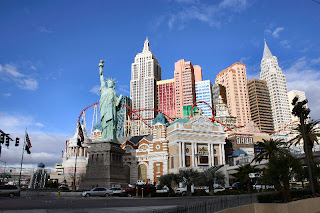          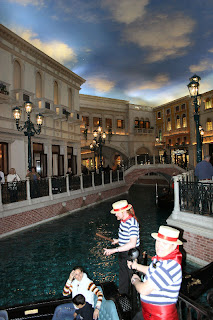   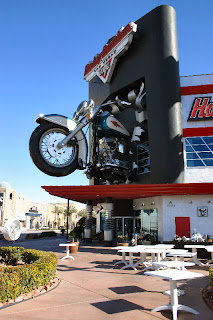 
|
|
 I think many of you might remember, that in those early posts of mine, I would only add one picture to each one of my posts. There are many of those posts that I would (retrospectively) like to go back and add many more pictures than just the single one I used to post at the time. Everyone seems to enjoy the increased numbers of photos that I started adding at several bloggers requests sometime last summer. This is one of those that definitely needs more photos and even more time for discussion.
I think many of you might remember, that in those early posts of mine, I would only add one picture to each one of my posts. There are many of those posts that I would (retrospectively) like to go back and add many more pictures than just the single one I used to post at the time. Everyone seems to enjoy the increased numbers of photos that I started adding at several bloggers requests sometime last summer. This is one of those that definitely needs more photos and even more time for discussion.


























































